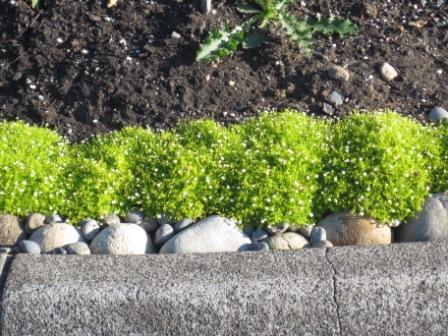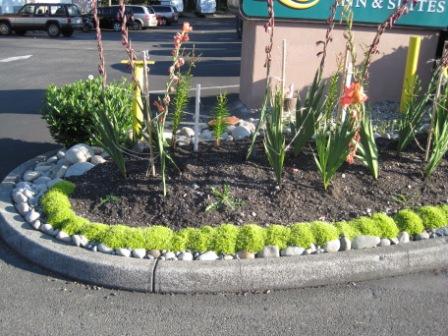A few weeks ago I was in Olympia (it misses you Bert!) reviewing grant applications. As I tend to do whenever I have time and my camera, I set out in search of gardening goofs that evening. Here’s the edge of a relatively new commercial site I discovered:

OK, not too bad so far. We’ve got a nice stone mulch next to the curb, then a lovely groundcover, in flower, that also functions as a living mulch. But what’s that we see in the upper half of the photo?

Yes, it’s Canada thistle (Cirsium arvense), an aggressive perennial weed that spreads by stolons and can make dense monocultures of prickly nastiness. In fact, the front is already advancing on our little groundcover:

Had the landscapers continued with mulching the soil rather than leaving it bare, these thistle seeds might not have germinated. But for whatever reason, the bulk of the landscape was left bare:

I’m sorry, but this just looks ridiculous. There was some obvious care in laying the stone mulch and groundcover, but then the landscaper seems to have run out of time and/or money and just plopped in some bulbs and corms. It reminds me of a birthday cake.
I don’t understand the rationale behind this. Was this a real design? Did the client run out of money? Or (as the more cynical side of me wonders) was this done deliberately to create a high maintenance landscape requiring lots of weeding in the future?
Thoughts?
It does look a little bare.
Thank you for addressing this, Linda. I have never understood why landscapers out west typically leave their soil bare. No one has ever given a reason. Maybe we will learn something this time.
I’m no garden designer but except for the ground cover everything is tall.
This may be a little nitpicky, but…isn’t that bull thistle rather than Canada thistle? Bull thistle has large nasty thorns and can grow 6′ in height! Makes for a pleasant walk in a field 🙂
Not sure about this site but in Southern California no one uses mulch, except for, occasionally, gravel. The reason? Fire. A nice thick bed of wood mulch toward the end of the dry season becomes tinder.
HA!!! That’s really atrocious. I can’t imagine that a client who found this particular bed acceptable would give a hoot about whether or not it was weedy. Glads as a FILLER! On the positive side, t
his design sure makes me feel better about my own skills as a designer 🙂 Glads as a filler…
I does look odd. It is easy to put do mulch and pine straw is a great on and looks great.
John, it’s definitely Canada thistle (bull thistle has hairy leaves and these are smooth). I actually prefer dealing with bull thistle because it doesn’t spread vegetatively like Canada thistle. (I should have said the latter spreads by rhizomes, though, and not stolons.)
Forget the mulch or lack thereof, the plant pallet is totally lacking in any sense of aesthetic whatsoever. It’s pretty woeful. It does look like a birthday cake, Linda! Ha!
Uh-huh….. So back to the original question: Why no mulch? I accept that mulch does not have to be organic.
I don’t find the lack of mulch being a concern. The plant selection/design is a bit bothersome tho. Living in a climate where prolonged summer dry spells is the norm, I do find mulch valuable for moistre management. And do the fact that when not ion a prolonged dry spell we may be subject to frequent rains, I also find mulch valuable for weed control.
But under no circumstances do I view mulch as a neccessary design element. Mulch is a functional item for me. Hey the Europeans by and large have gardened very successfully for centuries with out a compulsion for mulch.
This looks like a “home” job to me. I do not think a landscaper was involved.
I’m not sure about other areas but here in California about 60%-70% of the native bee population dig their nests in bare soil and will not build nests in areas that are covered in mulch. With the problems we are having with European honey bees, encouraging native bees in urban areas may become more and more necessary to get the pollination results we desire in our gardens.
Non-mulchers, anti-mulchers, and the native bee factor: the debate about mulch intensifies! I must add that when I broke down and mulched a client’s most problematic garden area this season with an attitude of “it’s easier to ask for forgiveness than permission” I was absolutely horrified during the process of covering up the entrance holes of the native ground-dwelling bees. HORRIFIED. But it had to be done, and it helped so much! The 1-2 inches of arborist chip saved that area (and many others) from certain desiccation in this season of almost zero rainfall in the Canadian PNW. I hate messing with the local fauna and it seems that every time I look sideways at a landscape that’s what happens. What to do? And to add to the general debate: what do I say to my clients when they ask if the arborist chip will increase the “woodbug” population that I have to say is already at an all-time high?
Not only bees, but some beneficial solitary wasps also like bare patches. One of them, which likes sandy bare patches to nest is being used as a bio-assay agent for EAB in Canada and the NorthEast. PA is hoping to implement a like program next year, assuming grant funds are available.
I spoke to our entomology specialist at WSU today. He doesn’t think there’s been any work done (yet) on the effects of mulching on ground-dwelling bees. There’s a project waiting for someone! That being said, he also told me that such ground dwellers like loose, sandy soils. Many urban areas, such as the parking lot island above, are unlikely to have such soil in the first place.
@Linda-what is the weed that looks like canada thistle but has no thorns? I grew up in MI and always went by the rule that Canada thistle was thornless and bull thistle had the thorns? I feel like everything is a lie now 🙂
John, Canada thistles and bull thistles both have spiny leaf margins. Canada thistle has a smooth epidermal surface, while bull thistle continues with the spiny nastiness on its epidermis. There are other rosette formers that kind of look like Canada thistle but without spines, like cat’s-ear (Hypochaeris radicata).
Thanks Linda! I didn’t pay enough attention to weed ID that one year I was in turf school apparently!
I have apartments and landscapers. They occasionally have suggested barkdust (I assumed mulch) and a couple of times have spent the $1000+ to have it installed. It isn’t long before it disappears as they blow out the beds and I have bare soil again. Landscapers don’t seem to listen or learn. I now keep bare soil.